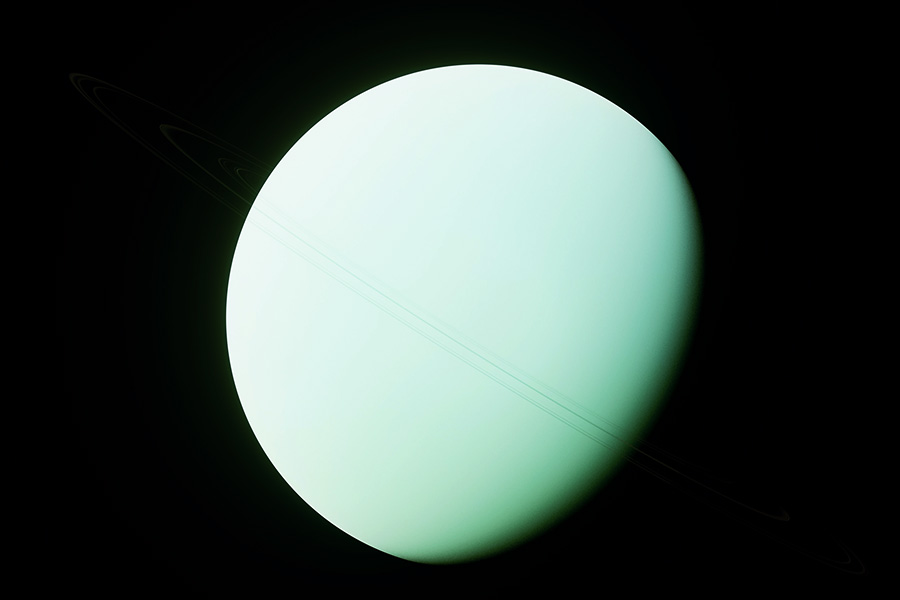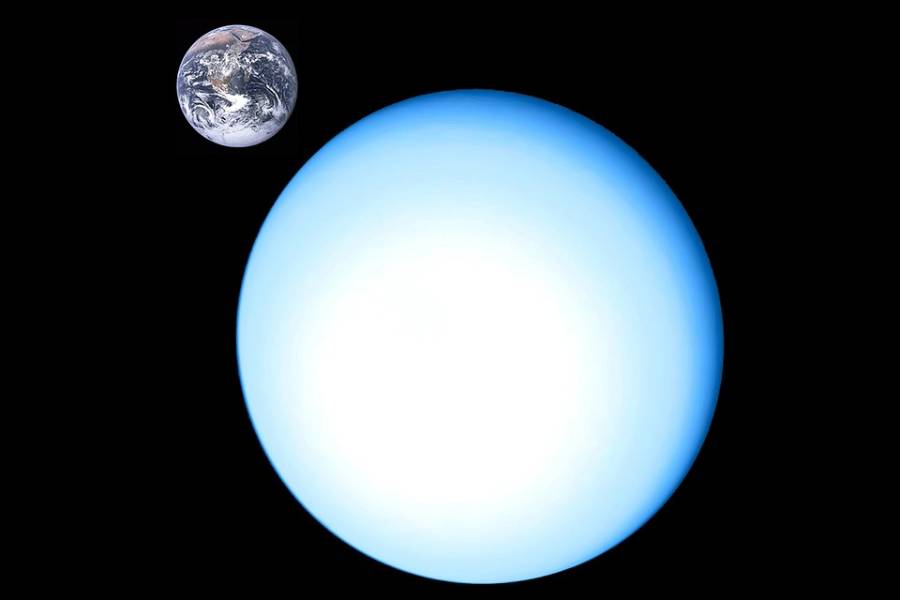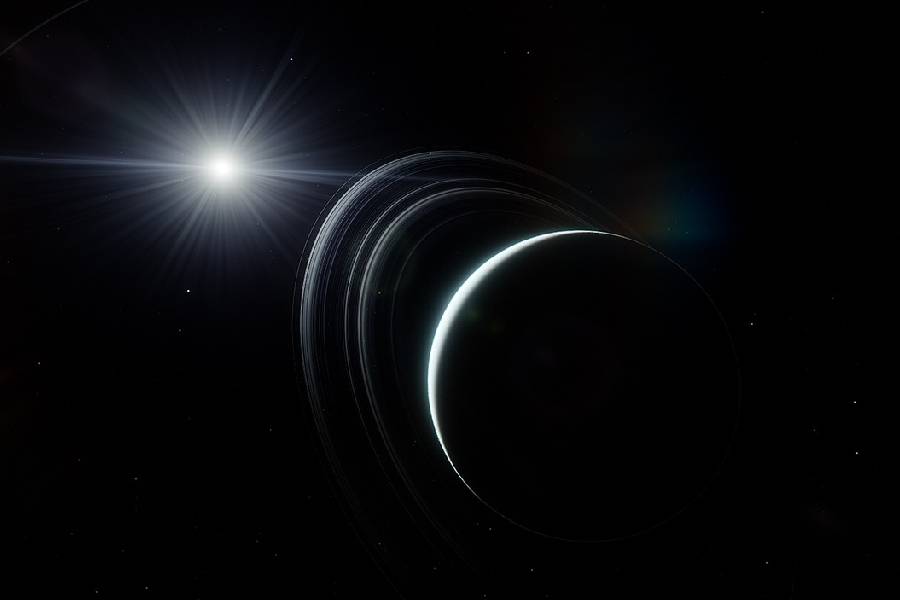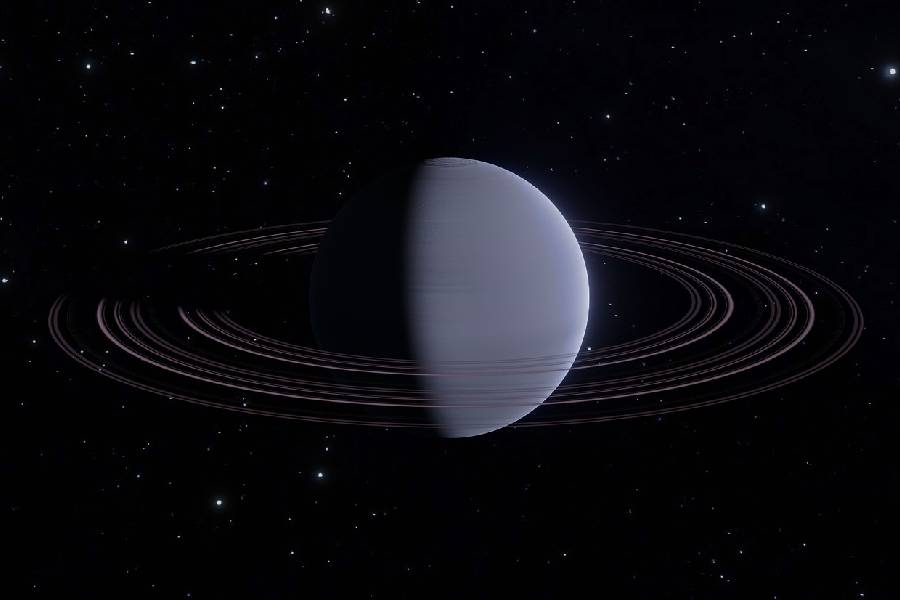Uranus compels our imagination with its sideways spin, messy magnetic field, and hazy blue-green atmosphere. Its fleet of moons and faint rings harbor clues to past upheaval and current secrets. But what about the Uranus climate?
Despite over 200 years of observation, Uranus remains the solar system’s planet of extremes. Tilted, frigid, and stormy, the outbound ice giant brews an exotic weather cocktail that fascinates astronomers and planetary scientists.
In this article, we’ll explore the remarkable climate of the planet Uranus—a world of extremes. We’ll uncover how its unique traits influence temperatures, seasons, winds, and storms.
Uranus Climate
Uranus has a frigid and unique climate characterized by extreme cold, high winds, and a lack of seasons as we know them on Earth. Its atmosphere is mostly composed of hydrogen and helium, with traces of methane, which gives the planet its bluish-green color.
The extreme axial tilt of Uranus causes it to experience long and harsh winters and summers, lasting for several decades each, making its climate highly unusual in our solar system.
So, what’s it like to stand on the surface of the coldest planet in the solar system? On Uranus, temperatures plunge below -350°F (-210°C), cold enough to freeze your breath instantaneously. This distant icy giant once held warmer beginnings before inexorably drifting into deep space and interminable winter.

Uranus’s Unique Atmosphere
When we talk about Uranus, one of the first things that comes to mind is its unusual atmosphere. This distant ice giant boasts a composition quite different from the more familiar planets like Earth or Mars. So, let’s take a closer look at what makes Uranus’s atmosphere truly unique.
Composition of Uranus’s atmosphere
Uranus’s atmosphere is mainly a mixture of hydrogen and helium. Sound familiar? These two gases are common in the universe, but there’s a twist. In Uranus’s case, they dominate the scene, making up around 98% of the atmosphere. You might be wondering, “What about the remaining 2%?” That’s where things get really interesting.
Role of hydrogen and helium
Hydrogen and helium are the dynamic duo of gases in the universe. They’re incredibly abundant, and you’ll find them in the atmospheres of most planets, including the giant ones like Jupiter and Saturn. But what’s remarkable about Uranus is its sheer amount of these gases.
Hydrogen and helium aren’t just hanging around for no reason. They play a crucial role in shaping Uranus’s unique properties. With such an amount of hydrogen and helium, Uranus doesn’t reflect much sunlight, so it lacks the bright, vibrant appearance of gas giants like Jupiter.
Abundance of methane and its effects
Uranus isn’t just about hydrogen and helium. It’s got a secret ingredient: methane. Methane is a colorless, odorless gas that you might know from Earth, where it’s a component of natural gas. On Uranus, though, methane is more like a silent partner in the planet’s look.
Methane in Uranus’s atmosphere gives the planet its distinctive bluish-green hue. It acts like a cosmic dye, soaking up the red part of the light spectrum and reflecting the blue and green. So, in a way, you could say that methane is the reason Uranus is the “aquamarine planet” of our solar system.
However, methane isn’t just about pretty colors. It’s a greenhouse gas that has a sneaky way of influencing Uranus’s climate. It traps heat from the Sun and keeps the planet’s temperatures from plunging even lower.
So, despite being so far from the Sun, Uranus isn’t entirely frozen solid. Methane keeps things a bit warmer than they would be otherwise. In a nutshell, Uranus’s atmosphere is a blend of hydrogen and helium, with a pinch of methane for added character.
This mix of gases, especially methane, gives Uranus its striking appearance and has a big say in its climate. Next time you gaze up at the night sky, you’ll better understand what’s going on in the distant world of Uranus.

Uranus and Its Climate Mysteries
Strange seasons of Uranus
Uranus is an undisputed champion of weird seasons. Its extreme axial tilt, nearly horizontal, results in some of the most peculiar seasons in the solar system. Instead of our familiar quarterly cycle, Uranus experiences seasons that drag on for decades.
One hemisphere bathes in sunlight for years, while the other languishes in darkness. Understanding the unusual mechanics behind these enduring seasons offers a glimpse into the planet’s climate dynamics.
Formation of methane ice clouds
Methane isn’t just a passive spectator in Uranus’s climate; it actively participates in creating the planet’s atmosphere. In the frigid temperatures of Uranus, methane can crystallize, forming methane ice clouds that drift through the atmosphere. These ice clouds testify to the planet’s unique climatic conditions and contribute to its distinct appearance.
Violent storms and wind patterns
Uranus may appear calm and serene with its bluish-green appearance but don’t be fooled. Beneath the surface, this ice giant hides a world of turbulent weather: violent storms, some as large as Earth, rage in its atmosphere.
The exact causes of these storms and the intricate wind patterns that govern them remain active research areas, adding to the ongoing intrigue of Uranus’s climate.
The Peculiar Axial Tilt
Most planets in our solar system have a pretty standard upright position, like a well-behaved spinning top, but not Uranus. This ice giant is the cosmic acrobat of the solar system.
Instead of having an almost vertical axis of rotation, Uranus rolls on its side. Yes, you heard that right – it spins nearly horizontally. This radical tilt is about 98 degrees, meaning it practically lies down as it orbits the Sun.
Imagine Earth deciding to somersault on its way around the Sun – that’s what Uranus is doing. And you might wonder, “Why would a planet do that?” The answer is still a bit of a cosmic mystery. Still, some theories suggest it might have collided with a massive celestial object long ago that knocked it sideways. Whatever the cause, this peculiar tilt makes Uranus stand out in our solar system.
The consequences of the tilted axis
Uranus’s sideways spin brings some strange consequences. One of the most significant is its extreme seasons. On Earth, we experience seasons because of our axial tilt, but Uranus’s tilt takes things to the extreme. Each of its poles faces the Sun directly for about a quarter of its orbit, leading to exceptionally long, harsh summers and winters that can each last for decades.
As one hemisphere basks in sunlight for years, the other remains plunged in darkness. This unusual seasonal pattern means that Uranus’s weather, temperature, and overall climate are like no other place in our solar system. The tilted axis is the main driver behind these interminable seasons.
Comparison to Earth’s seasons
To put this into perspective, think about Earth’s seasons. We enjoy a balanced cycle of spring, summer, fall, and winter, with each season lasting a few months.
Uranus, on the other hand, experiences seasons that stretch on and on. Imagine living through a summer or winter that lasts for decades, and you’ll get a sense of just how peculiar Uranus’s axial tilt makes its climate.
So, while Earth’s axial tilt adds variety to our lives with changing seasons, Uranus’s extreme tilt takes the concept of seasons to a whole new level. It’s just one more way this distant ice giant keeps us scratching our heads and marveling at the wonders of our solar system.
Temperature Extremes on Uranus
Uranus holds the title of the coldest planet in the solar system with an average temperature of -197 °C (-323 °F). The lowest temperature recorded on Uranus is -224 °C (-371 °F), measured in the planet’s upper atmosphere. At this frigid temperature, methane gas condenses into ice crystals.
Uranus is so cold because it receives very little energy from the Sun at its distance of nearly 3 billion km away. The little heat Uranus generates gradually leaks out into space, unable to replenish itself. Without an internal engine, Uranus lacks the warmth and activity seen on planets like Jupiter.

Temperature variations and unusual climate patterns
Despite being bitterly cold, Uranus does experience some regional and seasonal temperature differences. At the equator, it may reach a “balmy” -197 °C (-323 °F), whereas the poles can plunge to -224 °C (-371 °F) during their respective winter seasons.
As Uranus orbits the Sun, scientists observe brightening and dimming patterns as different areas receive more direct sunlight. Interestingly, Uranus seems brighter when farther from the Sun, possibly due to increased cloud formation. However, seasonal variations are more muted than on other planets due to the unusual 98-degree tilt.
Winds in the atmosphere redistribute heat globally, keeping temperatures more uniform. However, the lack of an internal heat source results in a largely stagnant climate system without features like Jupiter’s vortices and storms.
Clouds and Weather Patterns
Peering through the hazy blue atmosphere of Uranus, we find an intriguing assortment of cloud layers and patterns. Methane ice crystals condense in the coldest upper layers starting around -150 °C (-238 °F), while deeper down, water and ammonia clouds form at temperatures from -200 °C (-328 °F) to -220 °C (-364 °F). These cloud decks scatter light and contribute to Uranus’ muted blue-green complexion.
Furthermore, fierce winds up to 560 miles per hour zip around Uranus every 17 hours, transported by the planet’s rapid rotation. But unlike Jupiter and Saturn, Uranus lacks concentrated storms or giant ovals.
With minimal internal heat and few latitudinal temperature differences, the atmosphere forms smooth bands that encircle the planet rather than swirling vortices. Overall, weather patterns on the ice giant planet appear more uniform and stagnant than its gaseous cousins.
Magnetic Field and Auroras
Uranus has a skewed magnetic field, unlike any other planet. Tilted a puzzling 60 degrees from its rotational axis, the magnetic field is shifted away from the core deep into the mantle layer.
This warped field generates a magnetosphere that partially shields Uranus from solar radiation. When charged particles from the solar wind follow twisted magnetic field lines down to the atmosphere, they collide with particles to create dazzling auroras.
Observed auroras seem to form at lower altitudes than on other gas giants. When Voyager 2 visited in 1986, it recorded intense auroral activity triggered by a solar wind blast.
Yet, much remains unknown about Uranus’ irregular magnetic field and the auroras it may produce. Further study may reveal how this ice giant’s wonky field influences its climate and surfaces.

Climate Comparisons
Now we’ll contrast Uranus with other planets in our solar system. By examining these differences, we can better appreciate the unique features of this distant ice giant.
Contrasting Uranus with other planets
Comparing Uranus’s environment to some of its neighboring planets can help one fully comprehend it. Here’s a comparison with some of the more well-known planets in our solar system:
Uranus vs. Earth
The Earth is the gold standard for habitability, with its life-supporting climate. On the other hand, Uranus is extremely inhospitable due to its frigid temperatures and lack of a solid surface.
Uranus vs. Jupiter
Jupiter is the largest planet in our solar system and a gas giant like Uranus. However, Jupiter’s climate is dominated by its famous bands of colorful clouds, while Uranus sports a more serene, bluish-green appearance.
Uranus vs. Saturn
Saturn, another gas giant, has a majestic system of rings. While Uranus does have rings, they are much fainter and less prominent in its overall climate dynamics.
Uranus vs. Neptune
Neptune, the farthest planet from the Sun in our solar system, shares some similarities with Uranus, like a bluish hue. Yet, Neptune’s climate is characterized by intense storms and the fastest winds in the solar system.
Differences between gas giants
Uranus is classified as a gas giant among the planets in our solar system, but what does that mean? Let’s explore the distinctions that set Uranus and other gas giants apart:
- Composition – Gas giants are primarily composed of hydrogen and helium, much like the Sun. While this holds true for Uranus, Jupiter and Saturn also share this feature. However, Uranus’s atmosphere is unique due to its high methane content, which lends it a distinct color.
- Ring systems – Gas giants tend to have ring systems, and Uranus is no exception. Yet, its ring system differs from those of Jupiter and Saturn, with fainter and less numerous rings.
- Magnetic fields – Uranus has a particularly peculiar magnetic field tilted at a severe angle compared to its rotational axis. In contrast, Jupiter and Saturn have more conventional magnetic fields.
By contrasting Uranus with other gas giants in our solar system, we can better grasp the factors that make it a truly distinctive member of the planetary family. Its unusual climate and characteristics set it apart, reminding us of our celestial neighbors’ incredible diversity and complexity.
Climate Mysteries and Research
There is still much to learn about the Uranian climate system’s origins, development, and functioning. Scientists are unsure exactly how Uranus ended up with an extreme 98-degree tilt and a lopsided magnetic field.
The complex mechanisms of internal heat transfer are also poorly understood. Atmospheric dynamics, seasonal changes, ring and moon interactions, and other climate processes still confound researchers.
Future missions will aim to unravel Uranus’ many climate riddles. The proposed Uranus Pathfinder orbiter analyzed atmospheric composition, temperatures, auroras, and cloud layers.
Along with advanced telescopes, these missions provided invaluable data to enhance our models of this strange frozen world and grasp the intricacies of ice giant climates.

Frequently Asked Questions
What is the weather like on Uranus?
The weather on Uranus is overall relatively calm and featureless. The planet is extremely cold with minimum atmospheric temperatures of -224 °C (-371 °F).
It does not have significant internal heat like the other gas giants. As a result, there is little convection and mixing to drive interesting cloud features and storm activity typically associated with turbulent weather.
Are there storms on Uranus?
While Uranus does not have storms as massive and long-lasting as those seen on Jupiter and Saturn, some transient storms have been observed. Astronomers spotted a few relatively small dark spot storms persisting in the planet’s atmosphere for several years.
However, no storms nearly as dramatic as Jupiter’s Great Red Spot have been detected on Uranus’s mostly bland and placid surface.
Are there any notable weather patterns or atmospheric phenomena on Uranus?
There are a few subtle atmospheric features of note. Its atmosphere displays extremely high-speed winds of up to 560 mph, consistent with its rapid 17-hour rotation. Interesting seasonal brightness patterns have been seen, with increased activity when farther from the Sun.
Other phenomena like methane hazes, ice crystal clouds, and possible auroras reveal complex atmospheric chemistry and dynamics on this icy giant. But overall, Uranus exhibits a uniform global climate with minimal convection storms or turbulence.
Conclusion
Our journey through the Uranus climate reveals a planet of extremes, from scorching winds to temperatures colder than Antarctica. We discovered an atmosphere rich in methane ice and hydrogen that still holds secrets about Uranus’ formation and evolution.
The sideways tilt of this rolling ice giant immerses each pole in continuous day or night for decades, creating seasonal changes more muted than other worlds. While many questions remain in this remote, chilly world, each discovery about the Uranian climate unveils more about the diversity of planets in our solar system.
As we continue to unravel the complex influences that govern distant Uranus through advanced probes and telescopes, we move one step closer to grasping the intricacies of worlds both near and far.

